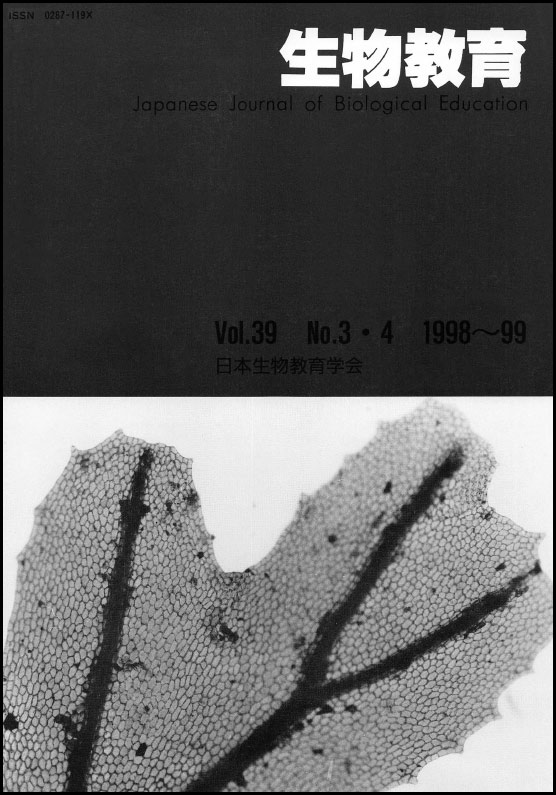
- Issue 3-4 Pages 122-
- Issue 2 Pages 58-
- Issue 1 Pages 2-
- |<
- <
- 1
- >
- >|
-
K. Morimoto, T. Nakamichi, R. Ninomiya1999 Volume 39 Issue 3-4 Pages 122-128
Published: 1999
Released on J-STAGE: April 09, 2022
JOURNAL FREE ACCESSUltraviolet (UV)-irradiated damage and photoreactivation were examined using plant materials. UV irradiation was carried out using a healthy UV lamp (UV-B) and a germicidal lamp (UV-C). After UV-irradiation, the damage in the leaves of morning glory and eggplant were examined, the number of fronds in duckweed was counted, the length of the hypocotyl in radish seedlings was measured, and the color of banana fruit peel was observed everyday.
In the morning glory and eggplant, the leaves that were irradiated by UV-B 30kJ/m2 and UV-C 2kJ/m2 became brown in color. The duckweed exposed to UV rays at 10kJ/m2 (UV-B) or 1kJ/m2 (UV-C) had fewer fronds. In radish seedlings, higher UV irradiation doses corresponded to shorter hypocotyl lengths. The part of the banana peel that was exposed to UV irradiation (UV-B, 1kJ/m2) changed in color, while the part that underwent photoreactivation did not change.
These experiments were carried out using simple tools and devices within a few weeks. Therefore, we propose that these experiments are useful for biology education in high schools.
View full abstractDownload PDF (18221K) -
T. Suzuki1999 Volume 39 Issue 3-4 Pages 129-139
Published: 1999
Released on J-STAGE: April 09, 2022
JOURNAL FREE ACCESSThe purpose of this paper is to clarify how and why our classification among various forms of “life” has influence on our views of the “respect for life”.
Firstly, science textbooks from elementary schools to high schools were analyzed from various viewpoints. Consequently it was clarified what kinds of “life” are used and how they are killed as teaching materials in school science. Secondly, in light of the five viewpoints about “life” which were developed by Suzuki (1996) based on bioethics, environmental ethics and animal rights, the differences among the three typical forms of “life” (fish, worms and plants) were clarified in the viewpoint of “respect for life”.
In conclusion, we pay attention to the “respect for life” when (1) “life” is more similar to us, (2) “life” has the capacity for suffering as far as we understand it, and (3) “life” is able to be recognized individually to us. However, if “life” does not correspond to these 3 areas, we focus on the “respect for life” from the standpoint of protection of species in the case that “life” is collected from the field.
View full abstractDownload PDF (29941K) -
M. Taguchi1999 Volume 39 Issue 3-4 Pages 140-147
Published: 1999
Released on J-STAGE: April 09, 2022
JOURNAL FREE ACCESSThe population structure of the damselfly, Calopteryx atrata was studied in a small stream surrounded by hills in Shiroyama, Kanagawa Pref. in 1993, using a mark and recapture method. The distribution range of individuals was limited within 800m along the stream, where water flows slowly. Males had a wider distribution than females both in the upper and lower directions of the stream. As for the movement along the stream males did not have clear tendency, but females showed the tendency to go upstream with time.
Based on the estimated number of individuals using the Jolly’s Method, the reliability of the estimation by the Lincoln’s Method was examined. When the interval of survey was long (e.g., 4 days or 7 days), the value calculated by the Lincoln’s Method was excessively large. This might be because the Lincoln’s Method left the death of individuals out of consideration. On the other hand, when the survey duration was short such as one day, little difference was found between these two methods. These suggest that a reliable value can be obtained by the Lincoln’s Method when we have less influence of the actual death of individuals by shortening the survey interval. As junior and high school students can easily make the calculation in the Lincoln’s Method, the introduction of this method into biology education will be appreciated.
View full abstractDownload PDF (24195K)
-
Y. Sekiya1999 Volume 39 Issue 3-4 Pages 148-154
Published: 1999
Released on J-STAGE: April 09, 2022
JOURNAL FREE ACCESSDownload PDF (20195K)
- |<
- <
- 1
- >
- >|